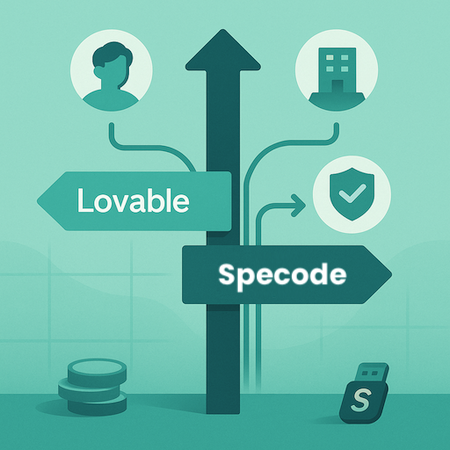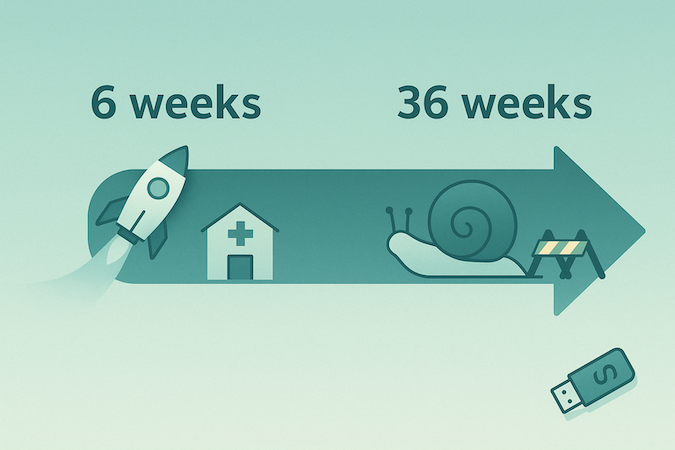Specode vs Lovable to Launch Health App: HIPAA in 6 Weeks, Not 6 Figures
Your demo-day sizzle fades the moment an investor asks, “Great mock-up—when’s the HIPAA audit?” Lovable can crank out prototypes fast, sure, but every shortcut today morphs into a five-figure compliance hangover tomorrow: BAAs, pen tests, refactors, DevOps therapy sessions.
Specode skips the self-inflicted wounds. Our pre-wired, HIPAA-ready components let clinician-founders ship a production-grade MVP in six weeks by using an AI builder—while your rivals are still pricing Supabase Enterprise. Want to spend your seed round on growth or on patching a low-code toy into something regulators won’t fine? This showdown spells it out: six weeks vs. six figures. Choose wisely.
Top Takeaways
- Six Weeks to First Patient
Specode’s pre-wired stack orchestrated via an AI chat turns demo code into an audit-ready MVP in ~40 days—while Lovable teams are still booking their first pen-test. - Dodge the Six-Figure Compliance Cliff
Hidden BAAs, annual audits, and a DevOps migration push Lovable’s real Year-1 bill toward $250 k+. Specode’s all-in cost lands under $55 k, with no “gotcha” upsells. - Own & Extend on Your Terms
Full repo control, plug-and-play integrations, and baked-in AI agent scaffolding mean you iterate without rewriting—or rerunning HIPAA gap analyses—every sprint.
Lovable’s True Price Tag
Lovable is a brilliant sandbox—fast, visual, cheap. But once your demo touches actual protected health information, regulators and enterprise buyers treat it like a teenager’s TikTok hackathon project. Three cost pillars kick in, and they’re non-negotiable.

The Compliance Gatekeepers
HIPAA’s first question is always, “Show me the BAA.” Every vendor that can see, store, or transmit PHI pulls you into its premium—or opaque—pricing tier. Miss one, and the whole stack flunks compliance.
Take-away: the “BAA tollbooth” is where budgets go to die. Fail to plan for it and you’ll be onboarding lawyers instead of patients. The $25/mo hobby plan is a teaser. Real-world HIPAA compliance starts four figures per month, per vendor.
The Annual Security Tax
Compliance isn’t a once-and-done checkbox; it renews like a gym membership you can’t cancel. Before signing an enterprise deal—or fundraising—expect:
- HIPAA audit: $10 k (gap analysis) → $150 k (enterprise HITRUST-grade). Median VC-backed startup: $35 k.
- Pen-test: $5 k (automated) → $50 k (white-box). Expect $22 k to keep investors happy.
These checks repeat every single year—and they only get pricier as your feature set (and attack surface) grows.
The DevOps Exit Tax
Lovable abstracts infra so you can drag-and-drop a prototype. Great for week-one velocity; lethal for week-twelve liability. Why you must migrate:
- Shared tenancy – You can’t isolate PHI in Lovable’s multitenant runtime.
- No encrypted backups under your key – Required by §164.308(a)(7).
- Limited audit-log retention – Investors and auditors demand 6-year logs.
- Unsupported BAAs – Core Lovable services (functions, storage) won’t sign.
- Vendor-lock scripting – Scaling forces you to rewrite server-side logic anyway.
“Migration” is polite fiction. You’re ripping out Lovable’s managed magic and rebuilding on AWS/GCP with Terraform, CI/CD, encrypted buckets, audit logs… the works.
- 80 hrs “good-enough” set-up @ $125/hr
- 160 hrs robust infra @ $150/hr
- 280+ hrs gold-plated, multi-region @ $175/hr
Hire cheap and you’ll pay the difference in incident reports.
What the migration actually entails:
And that assumes zero regressions or scope creep.
Putting It All Together
Real-world founders report 20-40 % overruns once scope creep and extra BAAs surface, so pencil in a $350 k floor if “selling to hospitals” is on your roadmap.
Bottom line
Lovable is phenomenal for ideation, but the moment you need to touch Protected Health Information you’re staring at six figures of compliance overhead—before a single growth experiment runs. Specode bakes those safeguards in, turning that money pit into a six-week sprint. Your call: fund audits or ship features.
Decision Matrix – Who Should Start Where?
I’ve watched more clinician-founders wheel demo-day prototypes into investor meetings than I’ve watched my kid’s Paw Patrol reruns—and trust me, the conversation always pivots to the same slide: “So… where does the PHI go?”

Some teams gulp and shuffle through an Excel graveyard of surprise BAAs; others whip out a clean cost sheet and move on to customer acquisition. The fork in the road is simple, but it gets blurry in the adrenaline of a startup runway. Use the cheat sheet below to keep your cash, timeline, and sanity intact.
How to read the table
- Need PHI in v1? Use Specode. Compliance tax flips Lovable’s TCO.
- R&D only? Lovable is fine—just slash the credit card after demo day.
- Investor meeting next quarter? Avoid a “Where’s your audit?” grilling; Specode’s baked-in BAA closes that gap.
Rule of thumb: If your roadmap says “patients” in the next 12 months, start on Specode and keep your runway for growth—not rewriting.
From Demo Day to Patient Day: 6 Weeks vs 36 Weeks
Speed isn’t a vanity metric in healthcare—it’s the difference between seizing a market window and watching a competitor claim it first. Below is a reality-check on what “time-to-first-patient” looks like on Specode’s pre-wired stack compared with a Lovable-first approach that you later have to rebuild for HIPAA.

Specode: 6-Week Fast-Track
Start on Specode and the calendar condenses into a single, predictable sprint.
Specode’s promise hinges on using vanilla components; heavy bespoke workflows push you to the 8-week bracket.
The first week locks down scope and signs the BAA, eliminating the legal back-and-forth that typically derails momentum.
Over the next two weeks, Specode’s automation spins up audit-logged infrastructure while designers drop in your branding.
By week four, core components—EHR integration, secure auth, tele-visit, payments—are already talking to each other in a fully encrypted environment. End-to-end tests run in week five, and by week six pilot patients are live on a stack that’s audit-ready out of the box.
For straight-off-the-shelf workflows, that six-week promise holds; heavier custom logic pushes you into the eight-week bracket, but you’re still months ahead of traditional timelines.
Lovable Prototype → HIPAA-Ready MVP: 36-Week Reality Check
Lovable shines at hack-day speed, but every shortcut shows up later as rework:
- Foundation & BAA wrangling (4 weeks). Stakeholders align, vendors are selected, and the first legal documents start circulating.
- Design & Prototype (8 weeks). Wireframes evolve into a Lovable demo, great for investor show-and-tell but far from production-grade.
- Core Development & Migration (12 weeks). Engineers refactor AI-generated Lovable code into a Next.js/Supabase Enterprise stack, stand up compliant infrastructure, and sign the Supabase BAA.
- Compliance & Testing (8 weeks). Pen-test, HIPAA gap analysis, and usability sessions with clinicians surface the inevitable “forgot-to-encrypt-that” fixes.
- Launch Prep (4 weeks). Production cut-over, staff training, and a cautious soft-launch wrap up the journey.
Even with tight project management, that’s roughly 36 weeks—and the research shows healthcare projects routinely over-run by 25-40 % when integrations or new regulatory wrinkles appear.
Why the Delta Matters
- Runway burn: Early-stage health-tech teams average $50 k per month in salaries and overhead. A 30-week gap between the two paths torches ≈ $250 k before a single invoice is sent.
- Lost upside: Delayed launch means deferred ARR and smaller market share. Models peg the opportunity cost of a six-month slip at $470 k–$1.34 m for apps targeting $100 k MRR.
- Morale & momentum: Teams that wait nine months to see live patient data often pivot, churn, or simply run out of steam.
Takeaway
If your roadmap includes real patients inside the next fiscal quarter, Specode’s six-week sprint turns technical due-diligence from a roadblock into a checkbox. Lovable remains a fantastic sandbox for mock-ups, but the moment PHI enters the chat, its early time savings flip into a nine-month, six-figure detour. Choose your lane accordingly.
CTO Checklist — Hidden Compliance Costs You’ll Regret Skipping
Even with a solid budget line for “security,” nasty surprises lurk in the footnotes. Run this gauntlet before you sign off on any stack—Lovable, Specode, or your cousin’s Kubernetes cluster.
1. Who signs the BAA—and what’s excluded?
If a vendor’s BAA covers only storage but not server-side functions, every scheduled Lambda is a breach waiting to happen.
2. Where do PHI backups live?
Nightly dumps on S3 are worthless if they’re in a non-HIPAA region or lack customer-managed encryption keys. Check region, KMS policy, and retention window.
3. Can you produce six years of audit logs—today?
HIPAA §164.312(b) isn’t optional. Verify log retention and exportability now, or budget $10–15 k later for a retroactive SIEM migration.
4. How many third-party APIs touch PHI—even transiently?
SMS, email, payment, eRx, labs, wearables—each needs its own BAA or a swap-out plan. Hidden cost: $2 k–$6 k / mo per “surprise” vendor.
5. Is incident response more than a Google Doc?
Carve out at least 40 engineer-hours for tabletop drills, breach notification templates, and on-call rotation updates. Skip this and your first security event becomes your last board meeting.
6. Do you budget for annual re-audit inflation?
Audit fees rise with feature count and user base. Expect 10–20 % growth year-over-year; lock multi-year pricing or watch the line item swell.
7. Who owns developer security training?
SOC-2 and HITRUST auditors now ask for proof of ongoing training. Allocate $200–$500 per engineer per year—or pay rush fees when the audit date looms.
8. What’s the exit strategy for patient data?
If a platform folds or pricing spikes, you’ll need scripted data egress, key rotation, and legal sign-off. Budget another 80-160 DevOps hours.
Quick litmus test: if any answer starts with “We’ll worry about that once we launch,” you’ve just spotted tomorrow’s six-figure line item. Fix it now, launch faster, and keep your CFO out of arrhythmia.
More Reasons the Smart Money Starts on Specode
Speed and cost are just the opening act. Specode’s architecture is engineered for long-haul ownership, not throw-away prototypes. Here are the advantages that rarely fit on a pricing slide but matter the moment you hit scale.

- Full code ownership—no hostage clauses
You deploy to your own Git repo and infra. Fork it, extend it, or hand it to an internal team without negotiating release fees. Investors love the word escrow; Specode makes it redundant.
- Custom-code freedom inside a no-code shell
Drag-and-drop for commodity workflows, direct edits for the 10 % that make your care model unique. You’re never boxed into someone else’s DSL or waiting on a platform roadmap.
AI Builder for Healthcare: Build by Conversation, See It Live
Describe the flow you want—intake → scheduling → messaging → billing—and watch it assemble with an instant preview. You start on healthcare rails (roles, consent, audit), connect your own data early so screens reflect real patients, providers, and payers, and theme it end-to-end. This isn’t “magic”; it’s sequence and focus.
- Prompt → preview: adjust fields, branching, validations, and reminders in seconds.
- Integration switchboard: EHR/EMR, labs, pharmacy/eRx, insurance, and custom APIs—stitched into your flows.
- Custom code when it counts: drop into code anytime; combine your team with ours on the Custom tier or spin up purpose-built AI agents.
- Guardrails for speed: Change Log restore and role-scoped testing keep fast iteration safe.
- Full code ownership: export anytime—no lock-in.
A true healthcare AI builder that lets you keep the keys, move faster, and focus on what makes your product defensible.
- Integration muscle baked in
Canvas Medical, Mirth, HL7, FHIR, eRx across all 50 states—plus pass-through connectors for labs, wearables, payments, and forms. If an API has a BAA path, Specode can wire it.
- Configurable AI agents—not bolt-on chatbots
Specode ships with agent scaffolding that plugs straight into your data layer, so summarising consult notes or triaging inbound messages takes hours, not quarters.
- Iterate without compliance déjà vu
Every new component inherits the same audit-logged, encrypted substrate—no rerunning a HIPAA gap analysis each sprint. Feature velocity goes up while security paperwork stays flat.
- Designed for clinician sanity
Virtual care, tele-psych, RPM—pre-built UI patterns focus on reducing click-fatigue and burnout. Less toggle sprawl, more patient face-time.
Bottom line: Specode isn’t “another low-code platform.” It’s a foundation that lets you keep the keys, customise endlessly, and bolt on AI as fast as the science moves—without reliving HIPAA 101 every release cycle.
Ready to see it live?
Stop theorizing and test-drive the stack yourself. Book a quick demo and we’ll walk you through:
- A real Specode workspace running HIPAA-grade infra
- How your existing workflows slot into our component library
- A tailored cost + timeline estimate based on your feature wish-list
Skip the sales call—open Specode’s AI builder, describe one change for your health app, preview in minutes, keep going after a quick sign-in—and when it’s real, ship on HIPAA-ready rails without the 6-figure tax.
Frequently asked questions
Technically yes, but you’ll pay twice—once for building the Lovable prototype and again for the DevOps rebuild, BAAs, and audits. Starting on Specode skips the six-figure migration bill and shaves roughly 30 weeks off time-to-patient.
No. You own the repo and infrastructure. Fork the code, add custom modules, or move everything in-house without a “release” fee or proprietary DSL standing in the way.
You can slot in custom code alongside Specode’s components, or request a new module. Either way, it inherits the same audit-logged, encrypted substrate—no fresh HIPAA gap analysis required.
Specode passes those fees through at cost: expect $850–$2,000 per month depending on usage. Unlike Lovable, you’re not hit with surprise “Security Edition” upsells for each vendor’s BAA.
Yes. Specode ships with agent scaffolding that plugs directly into your data layer, so you can roll out HIPAA-compliant AI workflows in days, not quarters—and without bolting a third-party chatbot onto PHI.









